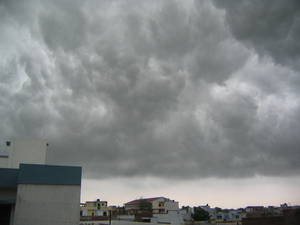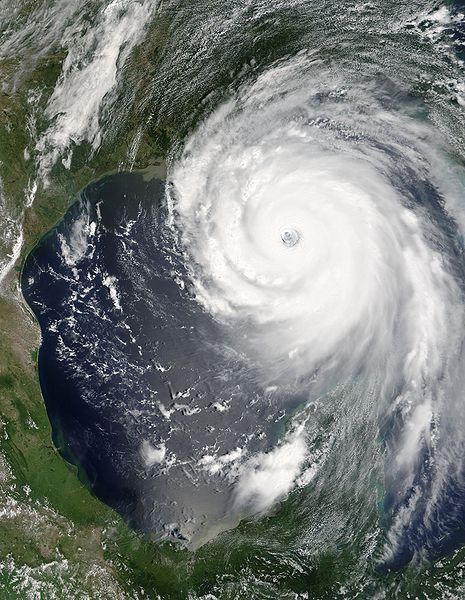Steering Hurricanes Out of Harm's Way
Interview with
Dave - Now we're going to go and talk to Dr Moshe Alamaro from MIT who's come up with a plan that could in theory be used to steer one of the most powerful forces of nature, the hurricane, away from danger. Hello, Moshe...
Moshe - Hello. Hi.
Dave - I guess the best way to start, what exactly is a hurricane and how do they form?
Moshe - Hurricanes in the Atlantic are formed in the mid-Atlantic, eastern Atlantic, and sometimes inside the gulf, the Caribbean Gulf. Then they travel west and eventually north-west and ultimately north. They are part of the global circulation. In fact, in active hurricane seasons, the temperature in Iceland is higher than usual and so, hurricanes are an essential part of the global circulation.
Dave - So they're moving heat around. What's actually the structure of hurricane itself?
Moshe - Well, the description would take too long, but the genesis of hurricanes is not  fully understood. It starts as a tropical storm. There are about 100 tropical storms in the Atlantic area. We cannot intercept all of them because they are beneficial. They bring rain to central America and the Southern United States. So if ever we are going to intercept hurricane, it will be when the hurricane has formed, because only 10% of the tropical storm are about become hurricanes. We will need to intercept the hurricane when it is in its full powers.
fully understood. It starts as a tropical storm. There are about 100 tropical storms in the Atlantic area. We cannot intercept all of them because they are beneficial. They bring rain to central America and the Southern United States. So if ever we are going to intercept hurricane, it will be when the hurricane has formed, because only 10% of the tropical storm are about become hurricanes. We will need to intercept the hurricane when it is in its full powers.
Dave - So, how are you intending to intercept them and affect them?
Moshe - Okay. Just to give you some numbers, the power of a hurricane is on the order of 10 million megawatts. The power of the combined electric grid of the world is only 3 million megawatts which is about a third of the typical power of a hurricane. So fighting a hurricane head to head is hopeless. But they can have an Achilles heel - a hurricane is not robust in its track and its intensity. So we found by simulation that if we change slightly the atmospheric conditions surrounding the hurricane, we would be able to divert the hurricane from its track to another track that might be less damaging.
Dave - So,a hurricane is actually quite sensitive to the conditions around it. Is this the reason why they're so hard to predict, where they're going to go naturally?
Moshe - Yeah. Now it's less hard to predict because we have a very good information about the surrounding atmospheric conditions. But as I said, it's enough to change slightly the temperature or humidity of the atmospheric conditions to cause a change, it could be a substantial change, and that was found through some computer simulations that we have done. Now, about the physical means to create perturbation to the hurricanes, there was a program which was ongoing until 35 years ago by NOAA (The US National Oceanic and Atmospheric Administration) and that program was called the Storm Fury Project. In this project, the cloud of the eye of the hurricane was seeded by silver iodide, and it was a project that was ongoing for 23 years.
What we tried initially is, instead of injecting silver iodide - which is a nucleus for freezing - [we tried] to inject ice by carrying water in aeroplanes, in high altitudes, freezing the water, and then using the ice instead of silver iodide.
Eventually, we found that the project Storm Fury was abandoned because it was already found that there is ice in the cloud and adding additional ice or silver iodide would not make any impact. But nevertheless, this development led to important technology that had nothing to do with hurricanes.
The second implementation or experiment that we did is with a material called a monolayer. It's a material that you place on water. It propagates and propagates until the width of the material is literally one molecule. And 25 grams of this material is enough to cover a square mile of water surface. The monolayer is effective up to 30-miles per hour but it's not effective in hurricane speeds.
Dave - So you're basically trying to affect the evaporation which would drive the hurricane - with hot water vapour rising - which actually powers the hurricane?
Moshe - Exactly. The water vapour rising and condensating and releasing of the evaporation heat is the source of the energy in the hurricane.
Dave - So what have you found which might actually work?
 Moshe - Until now, we didn't find any method that which is working. We are right now working on our 4th method which is spreading carbon black or soot on the top of hurricanes from aeroplanes and we have shown that this might change the thermodynamic of the hurricanes, lessen the intensity of the hurricane and/or be able to divert its track from one track to another.
Moshe - Until now, we didn't find any method that which is working. We are right now working on our 4th method which is spreading carbon black or soot on the top of hurricanes from aeroplanes and we have shown that this might change the thermodynamic of the hurricanes, lessen the intensity of the hurricane and/or be able to divert its track from one track to another.
Dave - Brilliant. How practical is this? How many planes would you need and I'm guessing the other big problem is if you drive hurricane into somebody else's city, they're going to be unhappy?
Moshe - Yeah. These are the major legal, ethical, political, and international issues with hurricanes because if this hurricane comes to one region, say a populated region, and then we divert it to a less populated [region], but in the less populated, some people are damaged. They will claim that the hurricane is not an act of God anymore, but we caused it.
Dave - And that could cause some really serious legal issues. Thanks Moshe. That was Moshe Alamaro from MIT on how we could theoretically steer hurricanes, if we can get the lawyers out of the way first.









Comments
Add a comment